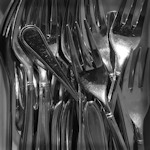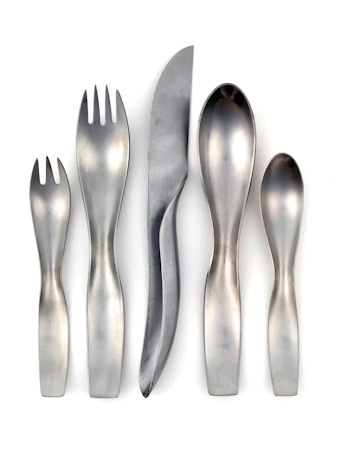
Mention cutlery and crockery in Vienna and thoughts tend to wander to gold-plated Habsburg treasures or the creative magic of Viennese Modernism. The Finer Dining exhibition at the Vienna Furniture Museum lets the 1950s and 1960s step out from the shadow of those illustrious eras.
- Main focus is the story of the Neuzeughammer Ambosswerk company and their cutlery
- Traces their international design success in the context of changing dining cultures
- Runs Sept 28, 2022 to April 16, 2023
- See also:
- Furniture Museum visitor & ticket tips
- Current design exhibitions in Vienna
Amboss design & dining culture 1950–1970

(Gratinierset Modell 200 with cardboard packaging; Carl Auböck, Neuzeughammer Ambosswerk, around 1959; private collection; press photo © Privatbesitz; photo by Edgar Knaack)
With war over, fascism defeated and the economy recovering, Austrians could turn to the finer side of life across the 1950s and 1960s. Cooking and eating became about more than just survival.
As part of that cultural change, interest inevitably grew in the design and aesthetics of tableware. Continuing industrialisation and mass production techniques also meant the rich no longer had a monopoly on attractive cutlery and crockery.
The Finer Dining exhibition explores that development through a focus on a notable manufacturer of the time: the Neuzeughammer Ambosswerk (or Amboss for short) in Upper Austria.
Although Amboss had been around for decades, they only moved into industrial cutlery production as such around 1950. The company soon became a groundbreaking producer of modern stainless steel designs for the next 20+ years.

(Cutlery model 7000, János Megyik, Neuzeughammer Ambosswerk, 1968-69, stainless steel, Sammlung Heinz J. Averwerser © Heinz J. Averwerser)
Such was the company’s design prowess that Amboss cutlery even makes an appearance in the collections of New York’s MoMA. Their success, both at home and abroad, drew on the creativity of numerous renowned designers, including:
- Carl Auböck, a painter and designer of international repute who designed, for example, the reversal lamp and “tree tables” that fetch five figure sums today
- Helmut Alder, whose groundbreaking Amboss 2050 set might be considered the first true modern cutlery design with its simplicity of form
- Janos Megyik, the acclaimed Hungarian artist and creator of the 1969 Amboss 7000 cutlery set that still features prominently on his website
Dates, tickets and tips
Discover the democratisation and revival of fine dining culture post-WWII from September 28th, 2022 to April 16th, 2023. An entrance ticket to the Vienna Furniture Museum includes the exhibition.
(And don’t forget the wider museum displays, which have gorgeous pieces of furniture from the past including some that played a role in poignant moments of history.)
If you wish to explore tableware design further while in Vienna, you’re in luck.
The Silberkammer in the Hofburg complex, for example, has crockery and cutlery from Imperial times. Everything from delicate porcelain tea services to cake moulds and huge decorated table centrepieces.
Viennese Modernism mentioned earlier brought forth its fair share of wonderful creations to eat from or with. The two best addresses for seeing examples are probably the MAK and Leopold museums. Look out, particularly, for the MAK’s temporary design exhibitions.
And two honourable mentions:
- The Augarten Porcelain Museum (no prizes for guessing the focus of their displays)
- The Espresso at last exhibition at the Jewish Museum location on Judenplatz (the exhibition tells the tale of a famous espresso café from the 1950s)
How to get there
Just follow the travel tips at the end of the main article on the Furniture Museum.
Address: Andreasgasse 7, 1070 Vienna